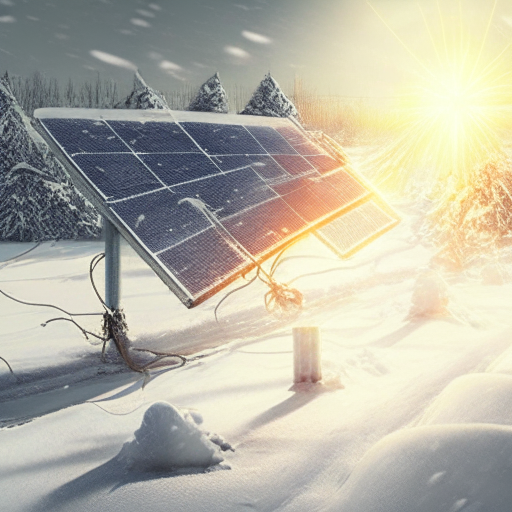Harness the Power of Solar Energy Efficiency Even in Extreme Cold Weather
As a committed survivalist, you recognize the critical need for achieving self-sufficiency, particularly when confronted with the formidable challenges presented by harsh winter conditions. One of the most pressing issues you may face is effectively utilizing renewable energy sources in frigid environments. Surprisingly, although the cold may appear to be a significant barrier, there’s no cause for concern! In this article, we will explore the untapped potential of solar power in cold climates. We are eager to share actionable strategies that will empower you to harness solar energy effectively, even during the harshest winter conditions, by adopting a proactive and knowledgeable approach to your energy requirements.

Many individuals mistakenly assume that solar electricity is only applicable in warm, sunny regions. However, thanks to remarkable technological advancements, capturing solar energy in colder climates is entirely feasible. Let us investigate the various innovative techniques that enable solar power systems to thrive in extreme cold and how you can leverage this sustainable, eco-friendly energy source to significantly enhance your lifestyle and survival strategies.
It is essential to grasp that solar panels generate energy from sunlight, not warmth. While lower temperatures may impact the efficiency of solar panels, they do not make them ineffective during winter months. By employing strategic planning and innovative methodologies, you can enhance your solar power system’s performance, ensuring optimal operation even in the coldest environments. Understanding how solar panels perform across varying temperatures will empower you to make informed decisions to effectively meet your energy demands.
One crucial factor for optimizing solar electricity in cold climates is the angle and orientation of your solar panels. Proper alignment can significantly boost the amount of sunlight your panels absorb throughout the day. During winter months, with the sun’s trajectory lower in the sky, tilting your panels at a steeper angle becomes essential. This adjustment allows for maximum sunlight capture, thereby improving their efficiency. Additionally, positioning the panels toward the south can further enhance their sunlight collection capabilities, which is particularly beneficial during the shorter days of winter.
Another significant challenge in colder regions is snow accumulation, which can severely hinder the effectiveness of your solar panels. A thick layer of snow can drastically reduce electricity output. However, by proactively addressing this challenge, you can discover effective solutions. Consider installing snow barriers or heating elements on your solar panels to prevent snow buildup. These enhancements not only facilitate the melting of existing snow but also ensure continuous energy production, even during snowstorms. Regularly clearing snow manually can also serve as an effective maintenance strategy to keep your panels functioning optimally and free from obstructions.
Implementing battery storage systems is a forward-thinking strategy that can significantly enhance solar power efficiency in cold conditions. These batteries store surplus energy generated during daylight hours for use when sunlight is scarce or temperatures drop. The necessity of battery storage becomes especially apparent in freezing conditions, as it guarantees a reliable supply of electricity when you need it most. By investing in a high-quality battery system, you can maintain your energy independence and be well-prepared for unforeseen circumstances that may arise during severe weather events.
Choosing the right type of solar panels is vital for optimizing your solar energy system’s efficiency in cold climates. Certain panels are specifically designed to perform better at lower temperatures and may utilize enhanced insulation or specialized materials to minimize the adverse effects of frost and ice on their performance. By making an informed choice about the panel types that best suit your cold environment, you can maximize energy production and ensure that your solar power system effectively meets your energy requirements.
Beyond the technical aspects, having your solar power system installed by professionals experienced in cold climate conditions is essential. Skilled installers can provide best practices for installation, ongoing maintenance, and troubleshooting, offering invaluable insights into optimizing your system. Their expertise will help ensure that your solar setup operates at peak efficiency, even under the most challenging winter circumstances, ultimately enhancing the reliability of your energy source.
Maintaining a proactive and prepared mindset is crucial in survival scenarios. While solar power can serve as a reliable and effective energy source in cold climates, having backup generators or alternative energy solutions is paramount. These additional measures will act as a safety net in case of prolonged periods of low sunlight or unexpected system failures. By integrating solar power with other renewable energy sources, you can further bolster your energy independence and resilience, ensuring that you are well-equipped to tackle any weather-related challenges that may arise.
Solar energy is not confined to warm and sunny areas; it holds immense potential even in the coldest climates, provided it is strategically planned and technically advanced. By adjusting your panel angles, mitigating snow accumulation, incorporating battery storage, selecting suitable solar panels, relying on skilled installation, and having contingency plans, you can unlock the complete potential of solar energy in extreme cold. Embrace renewable energy with confidence and resourcefulness, securing your survival and sustainability in any climate.
The post Solar Energy in Extreme Cold: Unlocking Its Full Potential appeared first on Survival Bite.
The Article Solar Energy’s Full Potential in Extreme Cold Conditions Was Found On https://limitsofstrategy.com
The Article Unlocking Solar Energy’s Potential in Extreme Cold First Appeared ON
: https://ad4sc.com


Your insights on harnessing solar energy in cold climates are particularly relevant in today’s context, where we are continually navigating the impacts of climate change and seeking sustainable solutions for self-sufficiency. It’s fascinating to note that solar panels can actually operate more efficiently in colder temperatures, as the panels can absorb light more effectively without overheating, which is a common misconception.
You’ve highlighted a really interesting aspect of solar energy that often gets overshadowed by the focus on how it performs in warmer conditions. It’s true that in cold climates, the panels can perform surprisingly well due to that lack of overheating. I think this opens up a lot of opportunities for areas that might traditionally think solar isn’t a viable option because of their climate.
It’s great to see you engaged with the topic! You’re spot on about solar panels performing better in the cold. A lot of people usually think heat is the key player, but it’s all about that delicate balance of light and temperature. When it’s colder, those solar cells can function efficiently without getting all heated up.
It’s great to see your interest in solar energy in colder climates. You’re spot on about the efficiency of solar panels in lower temperatures—they can really shine when it comes to absorbing sunlight without overheating. Many people don’t realize that performance can actually improve in cooler conditions.
It’s fascinating to consider how solar energy’s potential extends beyond just sunny days, especially for those of us focused on self-sufficiency and survivalism. I’ve always been intrigued by the idea of adapting technologies to fit unique challenges, like harnessing solar power in the dead of winter.